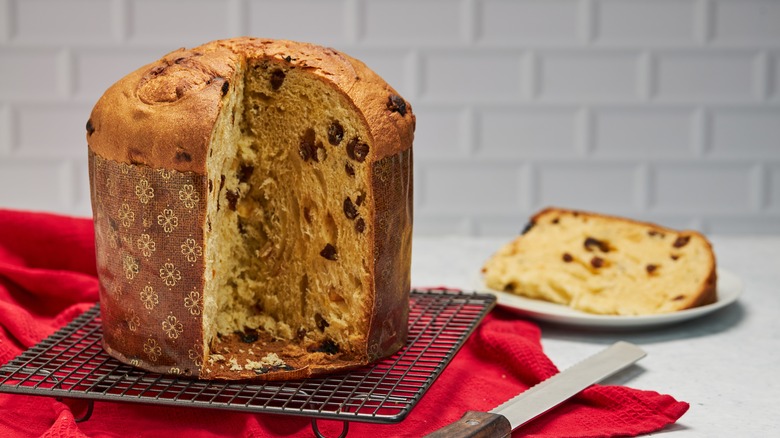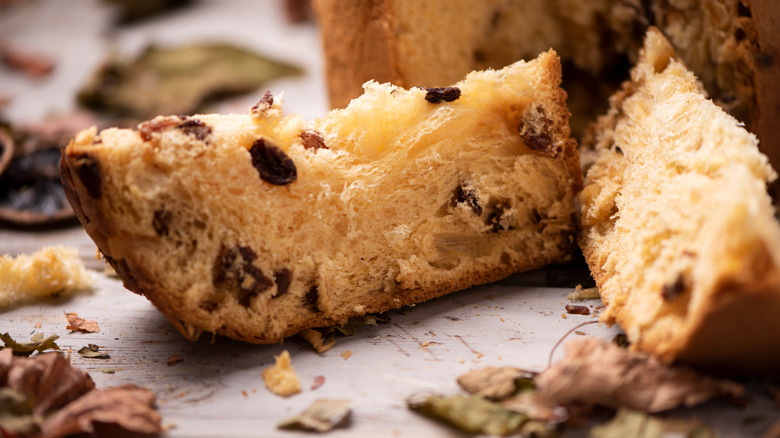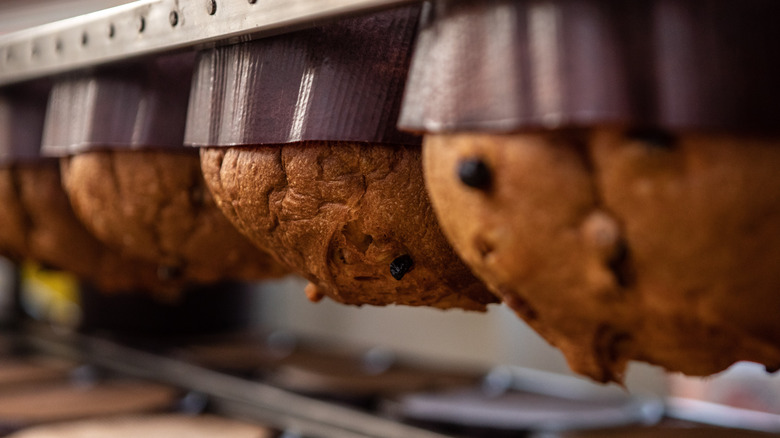The Origin Story Of Panettone Sounds Like A Hallmark Holiday Movie
No Italian Christmas table would be complete without sweet holiday breads, and there are many to choose from. According to Walks of Italy, there is the honey and spice panforte from Siena. Tuscan bakers make panpepato, which is not unlike gingerbread and contains cloves, nutmeg, honey, and dark chocolate. Pandolce, which is also enriched with spices and candied fruit, graces tables in Genova. Roman bakers make pangiallo, which is filled with nuts, candied fruit, raisins, and spices.
And then there's Milan's panettone, the sweet, rounded loaf dotted with raisins and candied orange and lemon peels. The making of panettone today is strictly governed by the Italian Consortium of Artesan panettone (CIPA), which ensures that all its members meet the same standard when making it. All panettone must be made with live yeast and be free of preservatives, hydrogenated fats, or ingredients made from genetically modified organisms (GMOs). CIPA even has the Italian Ministry of Industry's stamp of approval which, per SF Gate, has said that even the name "panettone" can only be used by specific producers.
Panettone is the stuff of legend
CIPA claims that panettone was first made in the 15th century — but its precise origins depend entirely upon whom you ask. One legend calls the panettone a "harbinger of love" because it sits at the heart of a love story between a medieval baker's daughter Adalgisa and Ughetto, whose family is opposed to their marriage. Ughetto, driven by love, decides to work at Adalgisa's family bakery, and he devises a bread made with sugar, butter, eggs, and candied citron. The product was so good that it reversed the fortunes of the bakery, and Ughetto's family gave their blessing.
But that's not the only story woven around this mouthwatering holiday bread. Eataly also shares the story of 12-year-old Toni, who worked for the head pastry chef for the Duke of Milan and was in charge of creating a dessert for the Christmas Eve feast. Because the pastry chef was distracted, the intended dessert ended up being burnt and inedible, but Toni saved the day by adding butter, sugar, and citrus fruit to the leftover dough to create a pastry that eventually became known as pane di Toni or Toni's bread.
Panettones were given an upgrade in the early 20th century
Regardless of how it was first invented, the classic sweet bread was revised in 1919 by a Milanese baker named Angelo Motto, who, with multiple kneads and rises, gave the bread its distinctive dome-like shape, according to MasterClass. They are also hung upside down so that the heavy bread chock-a-block with candied fruit peel and raisins doesn't slump when cooling. Panettone is also leavened with a rich cultured dough, not unlike a sourdough starter. This yeasty "mother-dough" as MasterClass calls it, gives the bread an open and nonuniform crumb, and the escaping air from the yeast is why you'll see holes at the bottom of every loaf.
Though it's eaten like a cake —sliced and served into triangular wedges — due to its consistency, it's still considered bread. And according to Taste, any leftovers that make it past the holidays can be used as an ingredient for other sweet treats, including bread and butter puddings, trifles, or French toast.


